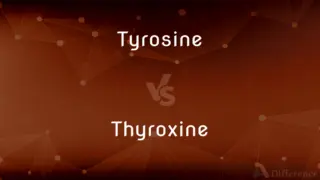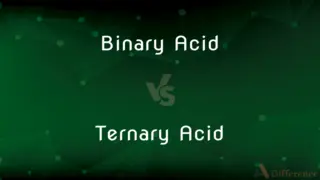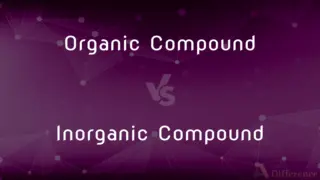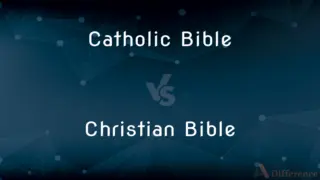Category vs. Type — What's the Difference?
By Tayyaba Rehman & Fiza Rafique — Updated on March 10, 2024
A category is a broad classification that groups items or ideas based on common characteristics, while a type is a more specific classification within a category, highlighting more detailed distinctions.

Difference Between Category and Type
Table of Contents
ADVERTISEMENT
Key Differences
Categories represent high-level classifications that organize concepts, items, or phenomena into groups sharing fundamental traits. For example, in the realm of vehicles, cars, trucks, and motorcycles might all fall under the category of "vehicles" due to their basic function of transportation. Types, on the other hand, refer to subdivisions within these categories that are based on more specific attributes or characteristics. Continuing with the vehicle example, within the category of cars, types might include sedans, coupes, and SUVs, which are distinguished by specific features like size, design, and intended use.
The distinction between category and type is essential for organizing information, allowing for a hierarchical structure in understanding and analysis. By first dividing items into broad categories, one can appreciate their general similarities before delving into the more nuanced differences delineated by their types. This hierarchical classification is prevalent across various disciplines, from biology, where living organisms are categorized and typed by traits and genetic makeup, to consumer products, which are categorized by purpose and typed by design or functionality.
Categories provide a macro-level view, offering a way to understand the overarching similarities between items, which is crucial for generalization and foundational knowledge. Types, in contrast, offer a micro-level view, essential for understanding specific variations and nuances within a broader category. This level of detail is vital for specialized knowledge, decision-making, and targeted analysis.
While both categories and types serve to organize and classify, categories do so at a more general level, grouping items by their most basic shared characteristics. Types dive deeper, providing specificity within these broad groups based on finer distinctions. The relationship between category and type is inherently hierarchical, with types serving as subsets within the broader categories.
Comparison Chart
Definition
A broad grouping based on common characteristics.
A specific classification within a category based on detailed distinctions.
ADVERTISEMENT
Purpose
To organize items or ideas into general groups.
To provide more specific classification within these groups.
Scope
Broad, encompassing a wide range of items or ideas.
Narrower, focusing on particular attributes within a category.
Level of Detail
General, highlighting fundamental similarities.
Detailed, emphasizing specific variations and distinctions.
Example
Vehicles: cars, trucks, motorcycles.
Cars: sedans, coupes, SUVs.
Compare with Definitions
Category
Offers a macro-level view.
The category of beverages encompasses a wide range of drinkable liquids, from water to soft drinks.
Type
A specific subclassification within a category.
Within the fiction category, novels, short stories, and novellas are types, distinguished by length and narrative style.
Category
A broad classification for organizing similar items.
In literature, fiction and non-fiction are categories based on the nature of content.
Type
Offers a micro-level view.
Within the beverage category, tea types like green, black, and herbal are distinguished by processing and flavor.
Category
Reflects general similarities among items.
The category of musical instruments includes strings, winds, and percussion, grouped by how they produce sound.
Type
Provides detailed distinctions.
In the car category, electric, hybrid, and gasoline are types based on their power source.
Category
Serves as the foundation for hierarchical classification.
In a grocery store, fruits and vegetables form separate categories based on their botanical classification.
Type
Focuses on nuanced differences.
The type of apple, such as Granny Smith or Fuji, is determined by taste, texture, and use.
Category
Essential for understanding and generalization.
Animal and plant kingdoms are categories that help in organizing biological life.
Type
Essential for specialized knowledge and decision-making.
Types of computer memory include RAM and ROM, which are used differently in technology.
Category
A class or division of people or things regarded as having particular shared characteristics
The various categories of research
Type
A person or thing exemplifying the ideal or defining characteristics of something
She characterized his witty sayings as the type of modern wisdom
Category
Each of a possibly exhaustive set of classes among which all things might be distributed.
Type
Characters or letters that are printed or shown on a screen
Bold type
Category
A specifically defined division in a system of classification; a class.
Type
A design on either side of a medal or coin.
Category
Aristotle's modes of objective being, such as quality, quantity, or relation, that are inherent in all things.
Type
An abstract category or class of linguistic item or unit, as distinct from actual occurrences in speech or writing.
Category
Kant's modes of subjective understanding, such as singularity, universality, or particularity, that organize perceptions into knowledge.
Type
Write (something) on a typewriter or computer by pressing the keys
He typed out the second draft
I'm learning to type
Category
A basic logical type of philosophical conception in post-Kantian philosophy.
Type
A number of people or things having in common traits or characteristics that distinguish them as a group or class:That type of car was popular in the 1970s. See Synonyms at kind.
Category
A property or structural unit of a language, such as a part of speech or a type of phrase.
Type
A person or thing having the features of a group or class:He is the type of person that is bound to get into trouble.
Category
A specific grammatical defining property of a linguistic unit or class, such as number or gender in the noun and tense or voice in the verb.
Type
An example or a model having the ideal features of a group or class; an embodiment:"He was the perfect type of a military dandy"(Joyce Cary).
Category
(Mathematics) A class of objects, together with a class of morphisms between those objects, and an associative composition rule for those morphisms. Categories are used to study a wide variety of mathematical constructions in a similar way.
Type
A person regarded as exemplifying a particular profession, rank, or social group:a group of executive types; a restaurant frequented by tourist types.
Category
A group, often named or numbered, to which items are assigned based on similarity or defined criteria.
This steep and dangerous climb belongs to the most difficult category.
I wouldn't put this book in the same category as the author's first novel.
Type
A figure, representation, or symbol of something to come, such as an event in the Old Testament that is believed to foreshadow another in the New Testament.
Category
(mathematics) A collection of objects, together with a transitively closed collection of composable arrows between them, such that every object has an identity arrow, and such that arrow composition is associative.
One well-known category has sets as objects and functions as arrows.
Just as a monoid consists of an underlying set with a binary operation "on top of it" which is closed, associative and with an identity, a category consists of an underlying digraph with an arrow composition operation "on top of it" which is transitively closed, associative, and with an identity at each object. In fact, a category's composition operation, when restricted to a single one of its objects, turns that object's set of arrows (which would all be loops) into a monoid.
Type
(Biology)The type specimen, type species, or type genus, which serves as the basis for the name of a species, genus, or family.
Category
One of the highest classes to which the objects of knowledge or thought can be reduced, and by which they can be arranged in a system; an ultimate or undecomposable conception; a predicament.
The categories or predicaments - the former a Greek word, the latter its literal translation in the Latin language - were intended by Aristotle and his followers as an enumeration of all things capable of being named; an enumeration by the summa genera i.e., the most extensive classes into which things could be distributed.
Type
A small block of metal or wood bearing a raised letter or character on the upper end that leaves a printed impression when inked and pressed on paper.
Category
Class; also, state, condition, or predicament; as, we are both in the same category.
There is in modern literature a whole class of writers standing within the same category.
Type
Such pieces considered as a group.
Category
A collection of things sharing a common attribute;
There are two classes of detergents
Type
Printed or typewritten characters; print:Let's see how your letter looks in type.
Category
A general concept that marks divisions or coordinations in a conceptual scheme
Type
A size or style of printed or typewritten characters; a typeface:a sans-serif type.
Type
A pattern, a design, or an image impressed or stamped onto the face of a coin.
Type
To write (something) using a typewriter.
Type
To input (something) manually on an electronic device, especially by using a keyboard.
Type
To assign to a category; classify or characterize:a political candidate who was typed as indecisive.
Type
To typecast:an actor afraid of being typed as a gangster.
Type
To write with a typewriter or computer keyboard.
Type
A grouping based on shared characteristics; a class.
This type of plane can handle rough weather more easily than that type of plane.
Type
An individual considered typical of its class, one regarded as typifying a certain profession, environment, etc.
Type
An individual that represents the ideal for its class; an embodiment.
Type
A letter or character used for printing, historically a cast or engraved block.
Type
(uncountable) Such types collectively, or a set of type of one font or size.
Type
Text printed with such type, or imitating its characteristics.
The headline was set in bold type.
Type
(taxonomy) Something, often a specimen, selected as an objective anchor to connect a scientific name to a taxon; this need not be representative or typical.
Type
Preferred sort of person; sort of person that one is attracted to.
We can't get along: he's just not my type.
He was exactly her type.
Type
(corpus linguistics) A word that occurs in a text or corpus irrespective of how many times it occurs, as opposed to a token.
Type
(theology) An event or person that prefigures or foreshadows a later event - commonly an Old Testament event linked to Christian times.
Type
(computing theory) A tag attached to variables and values used in determining which kinds of value can be used in which situations; a data type.
Type
(fine arts) The original object, or class of objects, scene, face, or conception, which becomes the subject of a copy; especially, the design on the face of a medal or a coin.
Type
(chemistry) A simple compound, used as a mode or pattern to which other compounds are conveniently regarded as being related, and from which they may be actually or theoretically derived.
The fundamental types used to express the simplest and most essential chemical relations are hydrochloric acid, water, ammonia, and methane.
Type
(mathematics) A part of the partition of the object domain of a logical theory (which due to the existence of such partition, would be called a typed theory). (Note: this corresponds to the notion of "data type" in computing theory.)
Categorial grammar is like a combination of context-free grammar and types.
Type
A symbol, emblem, or example of something.
Type
To put text on paper using a typewriter.
Type
To enter text or commands into a computer using a keyboard.
Type
To represent by a type, model, or symbol beforehand; to prefigure.
Type
To furnish an expression or copy of; to represent; to typify.
Type
To categorize into types.
Type
The mark or impression of something; stamp; impressed sign; emblem.
The faith they have in tennis, and tall stockings,Short blistered breeches, and those types of travel.
Type
Form or character impressed; style; semblance.
Thy father bears the type of king of Naples.
Type
A figure or representation of something to come; a token; a sign; a symbol; - correlative to antitype.
A type is no longer a type when the thing typified comes to be actually exhibited.
Type
That which possesses or exemplifies characteristic qualities; the representative.
Since the time of Cuvier and Baer . . . the whole animal kingdom has been universally held to be divisible into a small number of main divisions or types.
Type
The original object, or class of objects, scene, face, or conception, which becomes the subject of a copy; esp., the design on the face of a medal or a coin.
Type
A raised letter, figure, accent, or other character, cast in metal or cut in wood, used in printing.
Type
A simple compound, used as a model or pattern to which other compounds are conveniently regarded as being related, and from which they may be actually or theoretically derived.
Type
To represent by a type, model, or symbol beforehand; to prefigure.
Type
To furnish an expression or copy of; to represent; to typify.
Let us type them now in our own lives.
Type
A subdivision of a particular kind of thing;
What type of sculpture do you prefer?
Type
A person of a specified kind (usually with many eccentricities);
A real character
A strange character
A friendly eccentric
The capable type
A mental case
Type
(biology) the taxonomic group whose characteristics are used to define the next higher taxon
Type
Printed characters;
Small type is hard to read
Type
A small metal block bearing a raised character on one end; produces a printed character when inked and pressed on paper;
He dropped a case of type, so they made him pick them up
Type
All of the tokens of the same symbol;
The word `element' contains five different types of character
Type
Write by means of a keyboard with types;
Type the acceptance letter, please
Type
Identify as belonging to a certain type;
Such people can practically be typed
Common Curiosities
Can the classification of items into categories and types evolve over time?
Yes, as new information or perspectives emerge, the way items are categorized and typed can change to reflect better understanding or classifications.
What determines the classification into a category or type?
Classification is determined by the level of generality or specificity of the characteristics shared by the items or ideas being classified.
How do categories and types facilitate understanding?
They organize information hierarchically, making it easier to grasp general concepts before delving into specific details.
Is there a limit to how many types can exist within a category?
Theoretically, no. The number of types can expand as new distinctions or innovations emerge within a category.
How is the classification into categories and types applied in digital data organization?
In digital data organization, categories might represent major data groups, while types could be used to tag or classify data more specifically within those groups.
Are types interchangeable with subcategories?
Yes, in many contexts, types and subcategories are used interchangeably to denote specific classifications within broader groups.
How does the classification into categories and types affect decision-making?
It helps in narrowing down choices by filtering through broad groups first (categories) and then considering specific options (types) within those groups.
Do all categories have clearly defined types?
Not always. Some categories may have blurred lines between types due to overlapping characteristics or evolving definitions.
Can the same item be a type in one context and a category in another?
Yes, depending on the level of detail being considered, an item classified as a type in one context may serve as a category for further subdivision in another.
Can an item belong to multiple categories?
Yes, an item can belong to multiple categories based on different sets of shared characteristics.
Share Your Discovery

Previous Comparison
Onesie vs. Babygrow
Next Comparison
Seen vs. SceneAuthor Spotlight
Written by
Tayyaba RehmanTayyaba Rehman is a distinguished writer, currently serving as a primary contributor to askdifference.com. As a researcher in semantics and etymology, Tayyaba's passion for the complexity of languages and their distinctions has found a perfect home on the platform. Tayyaba delves into the intricacies of language, distinguishing between commonly confused words and phrases, thereby providing clarity for readers worldwide.
Co-written by
Fiza RafiqueFiza Rafique is a skilled content writer at AskDifference.com, where she meticulously refines and enhances written pieces. Drawing from her vast editorial expertise, Fiza ensures clarity, accuracy, and precision in every article. Passionate about language, she continually seeks to elevate the quality of content for readers worldwide.
















































